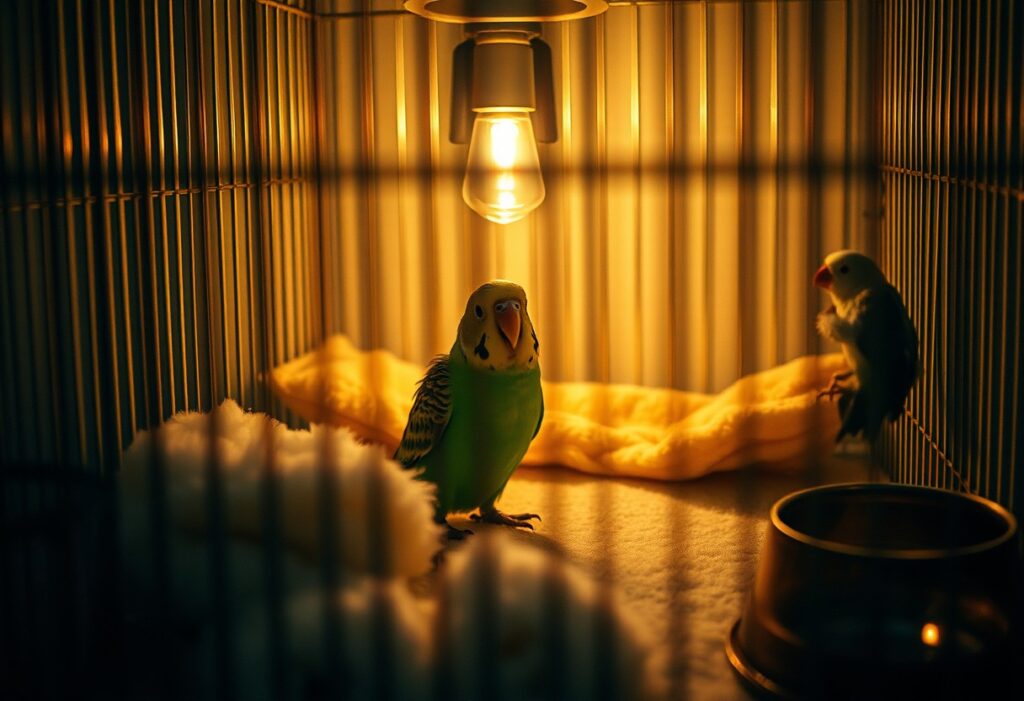Management of a bird that’s fearful of other animals is crucial for ensuring its well-being and happiness. Understanding your bird’s specific fears is the first step, as it allows you to create a safe environment. Gradual exposure to different animals can help reduce anxiety, but never force interactions. Consider providing safe spaces where your bird can retreat, and maintain a calm demeanor to instill confidence in its surroundings. With patience and careful planning, you can help your feathered friend navigate its fears effectively.


Understanding Your Bird’s Fear
As a pet owner, understanding your bird’s fears is crucial for creating a safe and comfortable environment. Birds are sensitive creatures and can be easily stressed by unfamiliar situations or other animals. Acknowledging your bird’s fear is the first step toward helping them feel secure and confident in their surroundings. In this chapter, we will explore how to identify common triggers and recognize signs of anxiety.
Identify Triggers
You need to pay close attention to what makes your bird nervous. Common triggers can include the presence of other pets, loud noises, or sudden movements. Spend time observing your bird’s behavior and note any patterns. For instance, does your bird hide when the dog walks into the room? Or does it get agitated when the cat jumps in nearby? By identifying these triggers, you can begin to mitigate your bird’s exposure to them and create a more peaceful environment.
Documenting these reactions can be beneficial as you try to piece together a pattern. This could involve keeping a journal where you note down each instance of stress-inducing exposure. Additionally, remember that each bird is unique; where one may feel threatened by a barking dog, another may not show any apparent anxiety. Understanding the specific triggers for your bird is key to effectively managing their fear.
Recognize Signs of Anxiety
If you notice your bird behaving unusually, it may be a sign of anxiety. Common signs include excessive chirping or squawking, flapping of wings, pacing, or even feather plucking. Being attuned to your bird’s body language is important for addressing their fears. A calm bird typically has a relaxed stance, while an anxious bird may have ruffled feathers and could be perched low, signaling discomfort. Pay attention to these subtle cues as they reveal a lot about how your bird is feeling.
Identifying these signs early on can prevent a minor issue from escalating into more severe distress. Providing a safe space where your bird can retreat when they feel threatened can significantly reduce their anxiety. Look for spots where they can feel secure, such as a covered cage or a cozy hideaway in their environment. It’s crucial to validate your bird’s feelings and show them that they are safe and loved.
Creating a Safe Environment
There’s no doubt that creating a safe environment is crucial for a bird that feels threatened by other animals. Birds are sensitive creatures, and their surroundings can significantly impact their behavior and stress levels. By establishing a comfortable habitat for your feathered friend, you can help reduce their anxieties and promote a sense of security. This process involves identifying safe spaces within your home and ensuring that your bird has areas where they can retreat when feeling overwhelmed.
Safe Spaces in the Home
For your bird, having designated separate areas in your home allows it to feel a sense of control over its environment. Try to create safe spaces that are away from potential sources of stress, such as other pets or loud noises. A cozy corner of a room away from high-traffic areas can serve as a sanctuary, outfitted with comfortable perches, toys, and minimal stimuli. Consider how your bird interacts with its surroundings, and adjust these spaces to cater to its individual needs and preferences.
Also, make sure these safe spaces are adequately enclosed and protected. You can use cages or bird tents to ensure your bird feels secure and is physically protected from any animals that may pose a threat. You might want to add calming items such as soft blankets or coverings to help your bird relax further when it retreats to its safe space.
Gradual Introduction to Other Animals
One approach to managing your bird’s fear of other animals is a gradual introduction. This process involves slowly allowing your bird to become familiar with other pets in the home without overwhelming it. Start by keeping the animals separated, allowing your bird to observe the other animals from a distance. This step is vital as it helps build its confidence and reduces the potential for sudden fright-related reactions.
Animals can often sense your bird’s fear and, depending on their temperament, may react curiously or aggressively. Therefore, ensure that interactions remain controlled and positive. Use treats and positive reinforcement during introductions to associate the experience with something pleasant for your bird. Over time, as your bird becomes more comfortable, you can gradually decrease the distance between them, ensuring that both your bird and the other animals feel safe throughout the process.

Effective Training Techniques
After understanding the root causes of your bird’s fear of other animals, you can implement effective training techniques to help your feathered friend become more comfortable and confident. These techniques focus on creating positive associations and gradually exposing your bird to other animals in controlled settings. The two most prominent methods are positive reinforcement strategies and desensitization practices, both of which can significantly improve your bird’s behavior and reduce anxiety.
Positive Reinforcement Strategies
One of the most effective ways to help your bird overcome its fear is through positive reinforcement. This technique involves rewarding your bird with treats, praise, or affection whenever it displays calmness or confidence around other animals. You can start by introducing a safe distance from the animal your bird is afraid of—this may be from across the room or behind a barrier. Each time your bird remains calm and composed, offer it a reward immediately to reinforce that behavior.
As your bird becomes more comfortable, gradually move closer to the other animal while continuing to use positive reinforcement. Make sure to keep the experience fun and rewarding; avoid forcing your bird into situations that could lead to increased anxiety. Over time, your bird will learn to associate the presence of other animals with positive outcomes, thereby reducing its fear.
Desensitization Practices
There’s another effective method known as desensitization, which involves slowly introducing your bird to the presence of other animals in a controlled and gradual manner. This practice starts with simply allowing your bird to observe the other animal from a distance. Once your bird shows signs of comfort at that distance, you can slowly decrease the space between them while ensuring your bird remains calm and in a safe environment.
A couple of necessary aspects of desensitization are to remain patient and consistent. It’s important to monitor your bird’s body language and behavior throughout this process; any signs of distress mean you may have to take a step back and allow more time for your bird to adjust. Your goal is to expose your bird to the other animals in small increments until it learns that these situations can be safe. Building that trust and reducing the bird’s anxiety can lead to a more harmonious life together, where your pet feels secure and confident around others.
Tips for Ongoing Management
Keep in mind that managing a bird that is afraid of other animals requires ongoing attention and a blend of patience and care. Over time, the goal is to create a safe environment and gradually introduce your bird to other creatures with the following strategies:
- Create a predictable routine to reduce stress and increase comfort.
- Use positive reinforcement to reward your bird for calm behavior when near other animals.
- Gradually increase the time your bird spends within sight of other pets or animals.
- Provide a safe space for your bird where it can retreat if it feels overwhelmed.
- Limit exposure to loud noises and chaotic environments that might increase anxiety.
This approach will help you foster a more manageable and less fearful interaction between your bird and other animals over time.
Monitor Progress Regularly
On a regular basis, it’s important to monitor your bird’s progress. Observe its reactions to various situations involving other animals. Keep a journal to track behavioral changes, noting moments of calmness along with incidents of fear or anxiety. This record can help you identify progress over time, and it can also provide insights into which methods are most effective for your bird.
Additionally, regular monitoring allows you to adjust your strategies as needed. If you notice your bird becoming less reactive, consider gradually increasing exposure to other animals. Conversely, if you see signs of heightened distress, it may be necessary to take a step back and repeat earlier training phases. Consistent observation will help you understand your bird’s individual needs and how best to meet them.
Consult with a Veterinarian or Animal Behaviorist
Monitor your bird’s behavior closely and don’t hesitate to consult with a professional if concerns arise. A qualified veterinarian or animal behaviorist can provide critical insights and tailored advice that can assist your bird in overcoming its fears. They might suggest behavioral therapy or recommend tools like calming pheromones or even medication in extreme cases.
Animal behaviorists have specialization in avian psychology and can craft a personalized approach to address fear in your bird. By utilizing their expertise, you can better understand the root causes of your bird’s fear and develop a tailored management plan. Collaboration with a professional can provide not only effective strategies but also peace of mind, knowing that you are taking the best possible steps for your bird’s health and happiness.
Final Words
Ultimately, managing a bird that’s afraid of other animals requires a combination of understanding, patience, and strategic intervention. You should begin by assessing the specific triggers that cause your bird to feel threatened, whether it’s other pets in the household or the sounds of outdoor wildlife. By creating a safe, secure environment, you can gradually reintroduce your bird to the presence of other animals—starting with controlled, minimal exposure and positive reinforcement techniques. This approach allows your bird to build confidence at a pace that suits its temperament, fostering a sense of safety and trust.
Moreover, establishing a consistent daily routine can greatly benefit your bird’s emotional state. You may want to incorporate desensitization exercises and reward-based training to help your bird associate other animals with positive experiences. Always remember to monitor your bird’s reactions and adjust your methods accordingly, ensuring their mental and physical well-being is prioritized. With dedication and the right strategies, you can help your bird overcome its fears, leading to a happier, more confident companion in your home.
FAQ
Q: What are the signs that my bird is afraid of other animals?
A: Signs that your bird is afraid of other animals include excessive vocalization, flapping wings, hiding, or attempting to escape when another animal is near. You may also notice that your bird becomes more agitated or withdrawn in the presence of other pets. Behavioral changes such as refusing to eat, excessive preening, or feather plucking can also indicate stress due to fear of other animals.
Q: How can I help my bird feel more comfortable around other pets?
A: Gradual exposure is key to helping your bird feel more comfortable with other pets. Start by setting up a safe and secure space for your bird where it can observe other animals from a distance. This allows your bird to become accustomed to their presence without feeling threatened. Gradually decrease the distance over time as your bird becomes more comfortable. Use positive reinforcement, such as treats and praise, to reward calm behavior when other animals are nearby. Always supervise the interactions to ensure safety, and never force your bird to interact if it shows signs of distress.
Q: When should I seek professional help for my bird’s fear of other animals?
A: If your bird’s fear is severe and leads to ongoing stress or health issues, or if it disrupts your household’s harmony, consider seeking help from an avian veterinarian or an animal behaviorist. Signs that professional help may be needed include persistent aggression, severe anxiety, or health concerns like weight loss or excessive self-destructive behaviors. A professional can provide tailored strategies and interventions, enhancing your bird’s comfort and well-being within your home environment.










